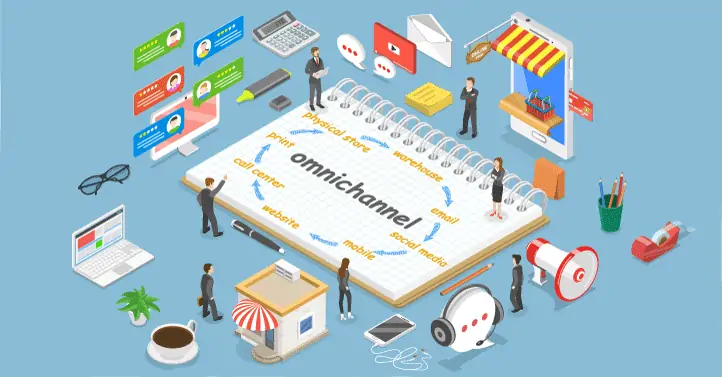
Omnichannel marketing integrates and cooperates with organizations’ various channels to interact with consumers to create a consistent brand experience.
This includes physical (e.g., stores) and digital channels (e.g., websites). An omnichannel marketing strategy aims to create a convenient, seamless user experience for consumers that offers many opportunities for fulfillment. An omnichannel strategy may allow consumers to find and purchase online in-store, such as “buy online and pick up in-store.” Today, organizations leverage omnichannel strategy across industries, including healthcare, retail, finance, technology, etc.
Thanks to online channels, modern consumers have more options than ever and expect information in real-time. Omnichannel marketing enables them to engage with brands on their terms, leading to a better customer experience overall.
What is Omnichannel Marketing?
Omnichannel marketing seamlessly integrates branding, messaging, and online and offline touchpoints as consumers move down the sales funnel, enabling a more impactful customer experience.
Omnichannel marketing takes a consumer-centric view of marketing tactics. Consumers can now interact with brands on numerous channels, from social media to customer service hotlines. An omnichannel approach ensures that the consumer has a positive, consistent experience on each track by offering a few key elements:
Consistent, identifiable brand tone and vision
Personalized messaging based on specific interests
Content that informs by past interactions and the current stage of the buyer’s journey
An identifiable brand simplifies brand recognition, while personalization based on interests and shopping history makes consumers more likely to interact with branded content across channels.
What’s the Difference Between Multichannel vs. Omnichannel?

While omnichannel and multi-channel are both concepts based on the idea of engaging consumers across multiple platforms, they are not interchangeable. Multi-channel looks at the specific channel and how it will complete the transaction there.
Alternatively, omnichannel considers that the customer journey may span multiple channels – and looks at how to create the best experience as consumers move between them. Each interaction is a touchpoint on a path, leading to a conversion. Let’s take a deeper look at the differences between the two:
Multi-channel
Multichannel is much simpler in its intention to distribute content and advertisements across various channels. A multi-channel strategy makes an organization available to consumers online, print, in-store, etc. The consumer can choose where they want to interact with the brand.
However, content and engagements within these various channels are often very siloed. With this in mind, multi-channel is more reflective of operations, reaching as many channels as appropriate, while omnichannel is more reflective of the overall customer experience.
Omnichannel
Omnichannel also makes brands accessible across online and offline channels. However, it goes a step further to ensure an integrated, seamless experience. Transitions are seamless as consumers move across devices and online and offline platforms, and prior encounters inform messages.
An omnichannel approach enables organizations to take a consumer-centric system that keeps the comprehensive customer journey top of mind.
The Benefits of Using an Omnichannel Approach
Today, most brands will agree that an omnichannel approach can yield the best results. While implementing an omnichannel strategy is far from simple, it offers many benefits when done correctly.
Today’s consumers are accustomed to being bombarded with messaging from various brands, and as a result, they have become increasingly selective about which brands they choose to engage with. Creating omnichannel customer engagements can act as a brand differentiator, bringing the following benefits:
A Better User Experience – Since omnichannel focuses on the individual experience across devices instead of the channel, the customer experience (CX) is better. By focusing on the customer instead of the platform, companies can drive more sales and better retention rates.
Cohesive Brand Strategy & Identity – Creating a seamless strategy across channels means building an easily identifiable brand image and tone. Organizations should base this image on core audience needs and values. By focusing on the overall experience and working within your brand guidelines to target each channel, you will have a more comprehensive brand strategy that will translate into increased loyalty and more targeted messaging.
Increased Revenue – An omnichannel approach encourages customers to engage with a brand across multiple touchpoints and channels. These increased, diverse engagements on each buyer’s journey can help increase revenue.
Research shows that customers who engage with various touchpoints tend to be 30 percent more valuable. This more targeted messaging also builds loyalty, making it more likely a customer will purchase from your brand again. Repeat customers, on average, contribute to 40 percent of revenue, despite being a smaller portion of your consumer base.
Better Attribution Data – Going truly omnichannel should extend to a user’s experience with your brand and your data analytics. By tracking engagements across channels, brands understand what the customer journey looks like, when and where consumers prefer to engage, and which campaigns have created the most value. Put this data back into your strategy to build more targeted campaigns and optimize media spending.
What is Omnichannel Attribution?

In a world where there are now multiple touchpoints across channels, which should get credit for the conversion? That can be difficult for marketers to answer without the appropriate attribution model. Marketers often rely on multi-touch attribution and media mix modeling (MMM) to understand what led to a conversion. However, these models are not perfect.
MMM: Media Mix Modeling only looks at long-term aggregate data rather than person-level insights. While this allows marketers to see a campaign’s impact on conversions and historical trends, such as times of the year when shoppers increase or decrease engagements, it does not provide insight into individual preferences. MMM also uses several years’ worth of data, meaning teams cannot use this model to optimize campaigns in real-time.
MTA: Multi-touch attribution offers granular, person-level data in real-time across each touchpoint. When analyzed, teams can use this data to make changes to campaigns as they run, to better cater to consumer needs. The challenge with multi-touch attribution is that it is difficult to determine how much credit should give to each touchpoint for a conversion. For example, was the webinar or the email campaign more influential in moving the consumer toward transformation?
Attribution models no longer rely on outdated practices and can now give a more holistic view of the marketing campaign and the buyer’s journey. Just as omnichannel tactics combine online and offline channels, omnichannel attribution removes silos between campaign measurements to understand each touchpoint’s role in the journey.
Leveraging omnichannel attribution offers a host of benefits to brands, allowing them to correlate online and offline measurements, and gain visibility into both person-level insights and aggregate, historical shopper trends.
Steps for Leveraging Omnichannel Marketing
As noted, creating an omnichannel experience needs to consider how the individual interacts with your brand. It focuses not on the channel but on the experience as a whole. With this in mind, there are a few essentials when it comes to creating an omnichannel experience:
- Data Collection
Collecting accurate, timely data about your consumers is essential to implementing an omnichannel strategy. This data will allow you to understand when your target audience prefers to interact with brands and on what devices, which messaging they are more likely to engage with, what products and features they are looking for, etc.
This data will be the driving force behind an omnichannel strategy. Brands need to make sure they have the tools to collect this data across online and offline channels effectively. An intelligent way to do this is with Unified Marketing Measurement (UMM). This attribution model combines the person-level metrics of multi-touch attribution with the historic, aggregate measurements of media mix modeling.
This way, touchpoints can be informed by individual preferences and historical trends such as regional or seasonal elements that affect engagements/conversions.
- Data Analysis
Data collection is only the first step. It is useless without a team and platform that can translate all of this big data into actionable insights. Brands need to deploy an analytics platform that can distill all of this data in near real-time so that teams can course-correct while campaigns run, to meet consumer needs at the moment.
- Customer Journey Mapping
Before launching an omnichannel campaign, organizations should be sure to create customer journey maps for each of their audience segments.
The customer journey map evaluates the steps taken between the customer discovering the brand and purchasing from the brand. Outlining these maps allows brands to create more targeted campaigns by considering individual interests, the user experience, interface, and factors outside of the brand’s control that may impact the path to purchase, such as economic factors.
- Brand Guidelines
Organizations need to develop a brand identity with clear guidelines for messaging and creativity. These guidelines should be adhered to across each channel to help facilitate brand awareness and recognition through a cohesive message.
Another way that organizations can help reduce an omnichannel experience is by leveraging brand tracking tools that can help measure and predict their brand’s health in the mind of the consumer
- Testing / Optimization
One of the most important components of an omnichannel marketing strategy is to continuously test the efficacy of your omnichannel approach. This enables the marketing team to determine ways to optimize campaign spending, messaging, creativity, and more.
Today’s organizations should utilize media planning tools that can run “what if” scenarios that take budget, target audience, multiple KPIs, and media mixes into consideration and, in turn, provide a highly granular media plan that can maximize ROI and inform future decision-making.
Conclusion
An omnichannel marketing strategy allows teams to meet their consumers where they are, with the right message at the right time. Organizations can deliver a unified customer experience through omnichannel marketing that acknowledges the previous touchpoints along the customer journey.
This fosters brand awareness in the mind of the consumer and leads to improved engagement, increased ROI and sales, and enhanced customer retention and loyalty.
Today, organizations can more easily enable an omnichannel experience for consumers through the help of advanced marketing performance measurement platforms that can offer reliable, person-level insights to identify the optimal media mix, targeting, and more. By analyzing the customer journey, organizations can make more informed decisions about optimizing campaigns and reducing wasted ad spending.
Private Agent for Dropshipping Success